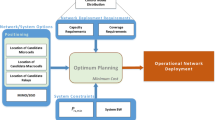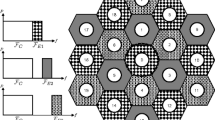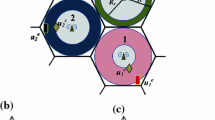Abstract
Two major planning problems are encountered when designing a cellular radio network. The initial question is where to locate the base transmitter stations such that full coverage is achieved at low interference. This is relevant for frequency division (FDMA) as well as code division multiple access (CDMA) technology. If the locations of base stations are given, then for an FDMA-system frequencies have to be assigned such that there is a sufficient number of channels per cell available at a low total interference level. Since cell site selection and frequency allocation have mutual influences on each other, the ultimate goal is to deal with both problems in a single design step. The main intention of this paper is to model the above planning issues as linear integer programs, and to discuss solution methods for the corresponding NP-hard problems. According to their increasing complexity we proceed from channel allocation via cell site selection to an integrated single setup.
Similar content being viewed by others
References
S. Fallot-Josselin, Automatic radio network planning in the context of 3rd generation mobile systems, in: Proceedings COST 259, Duisburg, September 1998.
M. Hellebrandt, F. Lambrecht, R. Mathar, T. Niessen and R. Starke, Frequency allocation and linear programming, in: Proc. of IEEE Vehicular Technology Conf., Houston, 1999.
K. Lieska, E. Laitinen and J. Lähteenmäki, Radio coverage optimization with genetic algorithms, in: Proc. of the 9th IEEE Internat. Symposium on Personal Indoor and Mobile Radio Communications, PIMRC 98, 1998, pp. 318–321.
R. Mathar and M. Hellebrandt, Fast and efficient automatic channel allocation in cellular radio networks, in: Proc. of Globecom 98, The Bridge to Global Communications, Sydney, 1998, pp. 1011–1015.
R. Mathar and T. Niessen, Optimum positioning of base stations for cellular radio networks, Wireless Networks (2000) to appear.
A. Monlin, G. Athanasiadou and A. Nix, The automatic location of base stations for optimized cellular coverage: A new combinatorial approach, in: Proc. of Vehicular Technology Conf. 99, Houston, May 1999.
M. Schmeink and R. Mathar, Preprocessed indirect 3D ray launching for urban microcell field strength prediction, in: Proc. of IEEE Conf. on Antennas and Propagation, Davos, April 2000.
K. Tutschku, Interference minimization using automatic design of cellular communication networks, in: Proc. of the 48th Vehicular Technology Conf., Ottawa, May 1998.
K. Tutschku, R. Mathar and T. Niessen, Interference minimization in wireless communication systems by optimal cell site selection, in: Proc. of EPMCC99, Paris, 1999, pp. 208–213.
K. Tutschku and P. Tran-Gia, Spatial traffic estimation and characterization mobile communication network design, Journal on Selected Areas in Communications 16 (June 1998) 804–811.
C. Yu, S. Subramanian and N. Jain, CDMA cell site optimization using a set-covering algorithm, in: Proc. of the 8th Internat. Telecommunication Network Planning Symposium, Sorrento, October 1998.
Author information
Authors and Affiliations
Rights and permissions
About this article
Cite this article
Mathar, R., Schmeink, M. Integrated Optimal Cell Site Selection and Frequency Allocation for Cellular Radio Networks. Telecommunication Systems 21, 339–347 (2002). https://doi.org/10.1023/A:1020958901292
Issue Date:
DOI: https://doi.org/10.1023/A:1020958901292




